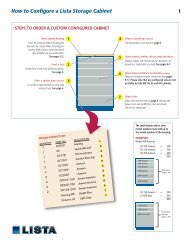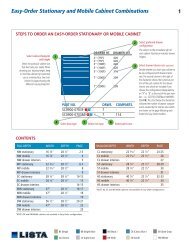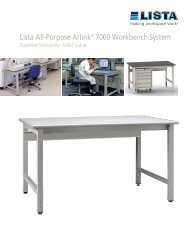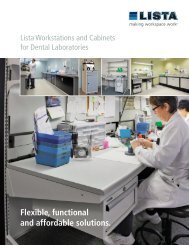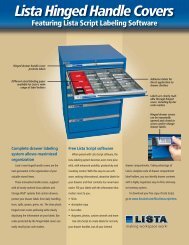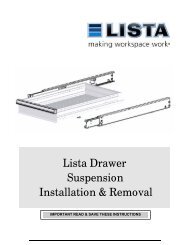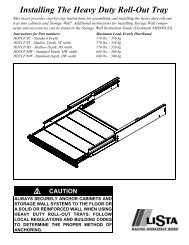Orange - Lista
Orange - Lista
Orange - Lista
You also want an ePaper? Increase the reach of your titles
YUMPU automatically turns print PDFs into web optimized ePapers that Google loves.
SPECIAL FIRE FIGHTING PROCEDURESFull protective equipment including self-contained breathing apparatus should be used. Water spray may be ineffective. Ifwater is used, fog nozzles are preferable. Water may be used to cool closed containers to prevent pressure build-up and possible autoignition or explosion when exposed to extreme heat.Section V HEALTH HAZARD DATAROUTES OF EXPOSUREExposure may be by INHALATION and/or SKIN or EYE contact, depending on conditions of use. To minimize exposure, followrecommendations for proper use, ventilation, and personal protective equipment.ACUTE Health HazardsEFFECTS OF OVEREXPOSUREIrritation of eyes, skin and respiratory system. May cause nervous system depression. Extreme overexposure may result inunconsciousness and possibly death.SIGNS AND SYMPTOMS OF OVEREXPOSUREHeadache, dizziness, nausea, and loss of coordination are indications of excessive exposure to vapors or spray mists.Redness and itching or burning sensation may indicate eye or excessive skin exposure.MEDICAL CONDITIONS AGGRVATED BY EXPOSURE: None generally recognized.EMERGENCY AND FIRST AID PROCEDURESIf INHALED: If affected, remove from exposure. Restore breathing. Keep warm and quiet.If on SKIN: Wash affected area thoroughly with soap and water. Remove contaminated clothing and launderbefore reuse.If in EYES Flush eyes with large amount of water for 15 minutes. Get medical attention.If SWALLOWED Never give anything by mouth to an unconscious person. DO NOT INDUCE VOMITING.Seek medical attention.CHRONIC HEALTH HAZARDSNo ingredient in this product is an IARC, NTP or OSHA listed carcinogen. Prolonged overexposure to solvent ingredientsin Section II may cause adverse effects to the liver, urinary, cardiovascular and reproductive systems. Reports have associatedrepeated and prolonged overexposure to solvents with permanent brain and nervous system damage.Section VIREACTIVITY DATASTABILITY:CONDITONS TO AVOID:INCOMPATIBILITYHAZARDOUS DECOMPOSITION PRODUCTS:HAZARDOUS POLYMERIZATIONSection VIIStableNone knownNone KnownBy fire: Carbon Monoxide, Carbon DioxideWill not occur.SPILL OR LEAK PROCEDURESSTEPS TO BE TAKEN IN CASE MATERIAL IS RELEASED OR SPILLED:Remove all sources of ignition. Ventilate and remove with inert absorbent.WASTE DISPOSAL METHOD:Waste from this product may be hazardous as defined under the Resource Conversation and Recover Act (RCRA) 40 CFR261. Waste must be tested for ignitability to determine the applicable EPA hazardous waste numbers. Do not incinerate.Depressurize container. Dispose of in accordance with Federal, State and Local regulations regarding pollution.===============================================================================================Section VIII PROTECTION INFORMATIONPRECAUTIONS TO BE TAKEN IN USE:Use only with adequate ventilation. Avoid breathing vapor and spray mist. Avoid contact with skin and eyes. Wash handsafter using.This coating may contain material classified as nuisance particulates (listed “As Dust” in Section II) which may be presentat hazardous levels only during sanding or abrading of the dried film. If no specific dusts are listed in Section II, The applicable limitsfor nuisance dusts are ACGIH TLV 10 mg/m3 (total dust), OSHA PEL 15 mg/m3 (total dust), 5mg/m3 (respirable fraction).Local exhaust preferable. General exhaust acceptable if the exposure to materials in Section II is maintained belowapplicable exposure limits. Refer to OSHA Standards 1910.94, 1910.107, 1910.108.RESPIRATORY PROTECTIONIf personal exposure can not be controlled below applicable limits by ventilation, wear a properly fitted organicvapor/particulate respirator approved by NIOSH/MSHA for protection against materials in Section II.When sanding or abrading the fried film, wear a dust/mist respirator approved by NIOSH/MSHA for dust, which may be generatedfrom this product, underlying paint, or the abrasive.PROTECTIVE GLOVESNone required for normal application of aerosol products where minimal skin contact is expected. For long or repeatedcontact, wear chemical resistant gloves.EYE PROTECTIONWear safety spectacles with unperforated side shields.



